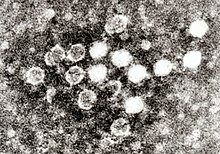
Back فيروس صغير ب19 Arabic فيروس صغير ب19 ARZ Parvovirus B19 Czech Parvovirus B19 German Parvovirus humano B19 Spanish Parvoviirus B19 Estonian B19 giza parvobirus Basque پارواویروس بی۱۹ Persian Parvovirus B19 French पारवोवाइरस बी19 Hindi
| Primate erythroparvovirus 1 | |
|---|---|

| |
| Electron micrograph of Parvoviruses in blood | |
| Virus classification | |
| (unranked): | Virus |
| Realm: | Monodnaviria |
| Kingdom: | Shotokuvirae |
| Phylum: | Cossaviricota |
| Class: | Quintoviricetes |
| Order: | Piccovirales |
| Family: | Parvoviridae |
| Genus: | Erythroparvovirus |
| Species: | Primate erythroparvovirus 1
|
| Synonyms | |
| |
Human parvovirus B19, generally referred to as B19 virus (B19V), parvovirus B19[1] or sometimes erythrovirus B19,[2] is a known human virus in the family Parvoviridae, genus Erythroparvovirus; it measures only 23–26 nm in diameter.[3] Human parvovirus b19 is a below-species classification of Erythroparvovirus primate1.[4] The name is derived from Latin parvum, meaning small, reflecting the fact that B19 ranks among the smallest DNA viruses. B19 virus is most known for causing disease in the pediatric population; however, it can also affect adults. It is the classic cause of the childhood rash called fifth disease or erythema infectiosum, or "slapped face syndrome".[5][6] The name comes from it being the fifth in a list of historical classifications of common skin rash illnesses in children.[7]
The virus was discovered by chance in 1975 by Australian virologist Yvonne Cossart.[3][6] The name B19 originated from the coding of a serum sample, number 19 in panel B.[6][8]
- ^ Servey JT, Reamy BV, Hodge J (February 2007). "Clinical presentations of parvovirus B19 infection". American Family Physician. 75 (3): 373–376. PMID 17304869.
- ^ Kahn JS, Kesebir D, Cotmore SF, D'Abramo A, Cosby C, Weibel C, Tattersall P (July 2008). "Seroepidemiology of human bocavirus defined using recombinant virus-like particles". The Journal of Infectious Diseases. 198 (1): 41–50. doi:10.1086/588674. PMID 18491974.
- ^ a b Heegaard ED, Brown KE (July 2002). "Human parvovirus B19". Clinical Microbiology Reviews. 15 (3): 485–505. doi:10.1128/CMR.15.3.485-505.2002. PMC 118081. PMID 12097253.
- ^ "Human parvovirus B19". NCBI. Retrieved 7 January 2024.
- ^ Vafaie J, Schwartz RA (October 2004). "Parvovirus B19 infections". International Journal of Dermatology. 43 (10): 747–749. doi:10.1111/j.1365-4632.2004.02413.x. PMID 15485533. S2CID 25660330.
- ^ a b c Sabella C, Goldfarb J (October 1999). "Parvovirus B19 infections". American Family Physician. 60 (5): 1455–1460. PMID 10524489. Archived from the original on 14 May 2008. Retrieved 6 November 2009.
- ^ "Parvovirus B19". CDC. Retrieved 25 February 2024.
- ^ Siegl, Günter; Bates, Robert C.; Berns, Kenneth I.; Carter, Barrie J.; Kelly, David C.; Kurstak, Edouard; Tattersall, Peter (25 July 2008). "Characteristics and Taxonomy of Parvoviridae". Intervirology. 23 (2): 61–73. doi:10.1159/000149587. ISSN 0300-5526. PMID 3980186.